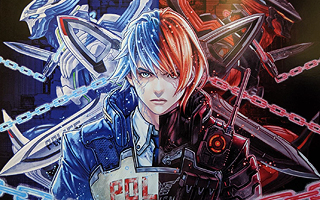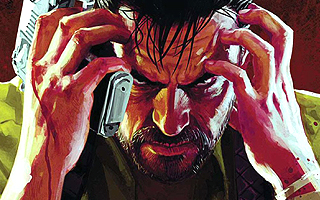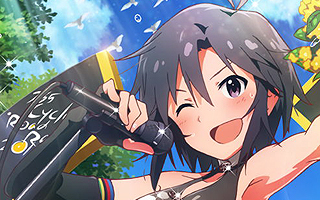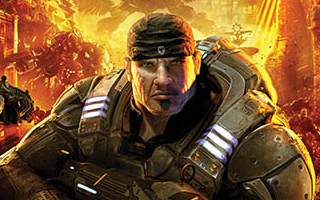Mulligan!
Top 10 Best Gaming Do-Overs of All Time!
In golf, a player may be permitted to take a mulligan after making an especially bad shot. This is essentially a do-over that acts as a safety net against bad luck or extenuating circumstances. The business world also offers opportunities for redemption when things don’t go as planned. On that note, this list looks at some of the most significant do-overs in gaming history. In some cases, game companies had to recover from disastrous product launches. In other instances, they completely misread the market and had to change their entire business models as a result. This topic encompasses a wide array of scenarios, but it’s fascinating to examine the various ways that companies have tried to redeem themselves after dropping the ball.
10
Atari’s Pac-Man Ports
1983

The early success of the Atari 2600 was largely driven by ports of popular arcade games. (Space Invaders effectively quadrupled the console’s sales in 1980!) Pac-Man was one of the biggest arcade games of the era, so Atari was convinced that it would re-ignite console sales. They took out ads in newspapers to declare April 3, 1982 as “Atari National Pac-Man Day,” and they went so far as to produce 12 million cartridges even though the 2600’s install base was only 10 million at the time. Unfortunately, the game was an unmitigated disaster. The port didn’t look or sound like the arcade game, and it was hindered by flickering graphics and unresponsive controls. This damaged customer loyalty and consumer confidence, and Atari had to write off five million unsold copies of the game. Pac-Man was rushed to market before it was ready, and in no way did it reflect the abilities of Atari’s programmers. Fortunately, the folks at Atarisoft were given multiple chances to redeem themselves. The company had secured the rights to all console versions of Pac-Man, so they released a vastly superior version on the Atari 5200 just one year later. Before you write this off as a cynical ploy to sell their new console, it should be noted that Atari also released a great Pac-Man port for the Intellivision in 1983. These ports proved that Atari’s developers were competent when they weren’t faced with unrealistic deadlines, but they weren’t much of a consolation to Atari 2600 owners. It just goes to show that a mulligan isn’t a “get out of jail free” card. Atari hit the ball out of bounds, took a do-over, and then proceeded to send the ball right into a water hazard. Although Atari deserves some credit for releasing better versions on other consoles, the Pac-Man fiasco did unspeakable damage to their reputation.
9
Metal Gear 2: Solid Snake
1990

There were several key differences between the MSX2 version of Metal Gear and the NES port. The original was a landmark stealth-based action game designed by Hideo Kojima, but liberties were taken on the NES. The dialogue was ridden with grammatical errors, the enemy AI was dumbed down considerably, and the story involved some dude name Vermon CaTaffy. (Also, the “Metal Gear” mecha for which the series was named didn’t even appear in the NES version, and was instead replaced by a generic super computer!) Despite its flaws, Metal Gear was a hit on the NES. Following its success, Konami began working on a sequel specifically for the North American and PAL markets. Snake’s Revenge was faithful to the Metal Gear concept for the most part, but it was clearly developed with Western sensibilities in mind. Kojima was not even aware that the game was being made until he had a chance encounter with one of the team members on a train ride. By the time the train had met its destination, Kojima had plans for a true sequel and had already mapped out the entire story. The next day, he asked for an opportunity to develop his version for the MSX2, and his request was granted. Metal Gear 2: Solid Snake was a remarkable achievement in 1990, and it introduced many themes and concepts that were still considered revolutionary when Metal Gear Solid was released eight years later. Snake’s Revenge is little more than a footnote, but it gave Kojima all the encouragement he needed to develop a proper sequel. There would be no Metal Gear Solid without Metal Gear 2, and there may not have been a Metal Gear 2 had Kojima not been motivated to correct somebody else’s mistake. In this instance, he basically took a mulligan on someone else’s shot!
8
Devil May Cry 5
2019

After a promising first entry, the Devil May Cry series fell off the rails with its first sequel. Capcom quickly corrected things with Devil May Cry 3 and spent the next decade or so pretending that the second game didn’t exist. This wasn’t the last time that Capcom would have to rescue the franchise. In 2013, several years after the fourth Devil May Cry game was released, Capcom decided to reboot the series for some reason. The reigns were handed over to Ninja Theory, and this resulted in the controversial DmC: Devil May Cry. The tone was changed drastically in the reboot, and the characters were edgier than they were before. Although the critical response was generally favorable, the sales were lower than expected. While the DmC experiment wasn’t an abject failure, there’s probably a reason why there weren’t any sequels set in its parallel universe. Just when it seemed like the entire series had been abandoned, Capcom announced Devil May Cry 5 in 2018. This game was a proper sequel to the fourth entry and completely ignored the ill-advised reboot. It was a return to form in many ways, and it was the “true” sequel that fans had been waiting for for nearly a decade. In golf, a mulligan is generally taken immediately after something goes wrong. In this case, Capcom waited years to set things right. They were effectively able to reboot the franchise just by pretending that the actual reboot didn’t happen. In this regard, Devil May Cry 5 is to Ghostbusters: Afterlife as DmC is to the all-female Ghostbusters from 2016.
7
Virtua Fighter Remix
1995

Virtua Fighter was something of a revolution when it hit the arcades in 1993, and it helped usher in a new era of polygon-based graphics. The game was far too advanced for contemporary consoles to run, so it seemed like an ideal launch game for the upcoming Sega Saturn. Ironically, a game that was intended to showcase the power of Sega’s newly-minted console had the opposite effect. Incidentally, the Saturn port of Virtua Fighter was poorly optimized and didn’t accurately reflect the machine’s capabilities. Moreover, flat-shaded polygons were no longer considered cutting-edge by the time the Saturn was released, and there were a number of upcoming fighting games that implemented proper texture maps. Based on the game’s performance, many critics openly questioned the capabilities of the Saturn. Sega decided to address these criticisms head-on by releasing an updated version of the game. Virtua Fighter Remix was essentially the same game with a brand new graphics engine. (It increased the polygon count, added texture maps, and revamped the fighting areas.) Overall, it was a much better representation of what the console could do. Remix landed on the Saturn a mere eight months after the original version, and it’s the game we should have gotten in the first place. The Saturn might have had more momentum out of the gate had there not been so many questions about its performance. It’s not uncommon for games to be upgraded when they’re inevitably re-released on next-gen consoles. However, it’s exceedingly rare for a game to be given a graphical overhaul on the same platform that it was originally released on. Virtua Fighter was supposed to be the Saturn’s killer app, but Remix rendered it obsolete within a number of months. The only reason why it’s not ranked higher on this list is because it ultimately failed to move the needle. Virtua Fighter 2 was right around the corner, so Remix was yesterday’s news within a few months.
6
Super Mario Bros. 2
1988

Super Mario Bros. is one of the most important video games ever, and it helped revive a dying industry in 1985. Nintendo wasted no time in releasing a sequel, and Super Mario Bros. 2 was on store shelves within nine months of the original… at least in Japan. There were a number of reasons why the game was a less-than-ideal sequel, however. Firstly, it was made for the Famicom Disk System, which was never released outside of Japan. Also, the sequel recycled most of its assets from the original and didn’t push boundaries in the same way. Finally, the game was intentionally difficult. This wouldn’t necessarily be a good fit for America, where Nintendo intentionally marketed the NES as a child’s play thing. The entire world (outside of Japan) was anxiously awaiting a sequel to the biggest game of all time, so Nintendo had to come up with something to satiate them. Their solution was to take another one of their Japanese exclusives and give it a new coat of paint. Yume Kōjō: Doki Doki Panic was a side-scrolling platformer that was developed as a tie-in with Fuji Television’s media technology expo. Since the expo had no visibility outside of Japan, the game was not a good candidate for international release. It was a fantastic game, however, so Nintendo decided to swap out the sprites and release it as Super Mario Bros. 2 in the West. Nintendo backed themselves into a corner with the “real” Super Mario Bros. 2, and they were left with a sequel that was not suitable for a global audience. It was fortunate that they had another game that was not suitable, since it led to one of the most celebrated video games sequels of its era. Western audiences had to wait three years for a “fake” Super Mario Bros. sequel, but I contend that Nintendo made the right call. You only get one chance to make a first impression, but Nintendo somehow found themselves with a second chance to make a second impression.
5
No Man’s Sky
2017

Sean Murray didn’t do himself a lot of favors while promoting No Man’s Sky. The founder of Hello Games was obviously proud of the game that he had worked on, but he made promises that he couldn’t keep and relied heavily on hyperbole. During interviews, Murray spoke about the game’s multiplayer component (which had already been removed), and was not upfront about the limitations of the game’s procedurally generated content. The poor communication caused a lot of backlash after the game’s 2016 launch, and some fans went so far as to compare Sean Murray to Peter Molyneux! Murray has since admitted that he failed to manage expectations, and Hello Games has taken a more humble approach with respect to its marketing strategies. Since the game’s initial release, it has slowly evolved into something that more closely resembles the game that was initially promised. It has received multiple updates, free of charge, and many new features have been rolled out. The missing multiplayer component is now an integral part of the game, and concepts like vehicles, base-building, and space fleet management have also been added. They were even able to patch in cross-platform play and VR support! The general reception of the game has dramatically improved since its problematic launch, and it has won multiple awards for its numerous updates. If nothing else, No Man’s Sky taught the industry an important lesson about what not to do during a publicity tour.
4
The Nintendo Switch
2017

Nintendo caught lightning in a bottle with the Wii, and their “blue ocean” strategy reached millions of new customers. The Wii U ultimately failed to retain the new audience, and the system fell flat on its face despite a steady stream of stellar first-party titles. This was largely because the main gimmick was half-baked. Nintendo had seen tremendous success with the DS and 3DS, and the rise of mobile gaming was impossible to ignore. For these reasons, Nintendo decided to build the Wii U’s entire identity around a unique tablet-like controller. Unfortunately, third parties had no incentive to support the device and Nintendo themselves often treated the second screen like an afterthought. The Wii U let you play games on your controller without the need for a television, but it lacked the conveniences of a proper portable system since you always had to be in close proximity to the console itself. The Wii U sold less than 14 million units worldwide, and it was Nintendo’s least successful home console by far. Many analysts wrote them off and predicted that they would leave the hardware business altogether. Thankfully, Nintendo was gearing up for a redemption arc. The Switch was the console that the Wii U should have been in the first place, and it was a true hybrid system. It could be hooked up to a television like a proper console, but it could also be used as a handheld. (Unlike the Wii U, the Switch didn’t require players to be tethered to any other devices.) This was a concept that immediately resonated with gaming audiences, and the system began breaking sales records around the globe. Nintendo learned a lot from the Wii U experiment, and they recuperated some of their losses by revisiting its library. Since nobody bought the Wii U, Nintendo realized they could simply port the games to the Switch and reach an entirely new audience. (Mario Kart 8 sold over eight million copies on the Wii U (somehow), but the Deluxe Switch version has raced past the 50 million mark.) Nintendo has ported over a dozen of its first-party Wii U games to the Switch, which makes it one of the most literal examples of a do-over on this countdown.
3
Xbox Game Studios
2017

Microsoft made tremendous strides during the Xbox 360 era, and the console ultimately sold four times as many units as the original Xbox. Momentum was on their side heading into the next generation, but they completely dropped the ball with the Xbox One. Seemingly every decision they made damaged the good will they built during the previous decade. Microsoft had envisioned the Xbox One as an all-in-one set-top box for your living room, so they decided to focus on television functionality and other features that nobody asked for. (Their proposed “always online” ecosystem went over like a lead balloon, while the requisite Kinect motion sensor only served to give the PlayStation 4 a competitive advantage in terms of horsepower.) The Xbox One was such a massive failure that Microsoft considered shuttering the entire division! Instead, they handed the reigns over to a junior executive named Phil Spencer, called for a mulligan, and prepared for the most drastic course correction the industry had ever seen. Seemingly overnight, they dropped Kinect like a bad habit and released a more powerful version of the Xbox One that compared favorably to Sony’s offerings. Behind the scenes they were putting plans in place for a robust subscription-based gaming service. Game Pass has since become the lifeblood of the Xbox division, and the company has made several industry-changing acquisitions in an effort to provide content for the service. The same company that put gaming on the backburner during the Xbox One generation has spent over 100 billion dollars buying other gaming studios and publishers. It used to be a running joke that all Microsoft had was Halo, Gears, and Forza. Now they own Call of Duty, World of Warcraft, Fallout, Elder Scrolls, Overwatch, Candy Crush, DOOM, Crash Bandicoot, Spyro, and the entire Sierra-Online catalogue. In 2013, Microsoft cared more about glorified TV guides than they did about games. Today, Xbox Game Studios is the single largest publisher in the history of the medium. If Microsoft hadn’t made so many mistakes during the Xbox One generation, it’s unlikely they would have felt the need to be so aggressive with their acquisitions. In a single generation, they went from, “We should probably just leave the gaming industry,” to “We should probably just buy the gaming industry.”
2
Final Fantasy XIV: A Realm Reborn
2013

Square Enix took a big risk by making Final Fantasy XI an MMO in 2002. Although it took a while to build a userbase, its subscription-based model made it the most profitable game in the series. The company had high hopes for Final Fantasy XIV when it launched in 2010, as the game had been in development for over five years. Although certain aspects of the game were praised, fans took exception to the gameplay, interfaces, and the overall layout of the world. It left a general impression of an unfinished game, and the criticism was so loud that Square Enix was forced to take action. Subscription fees were promptly halted and leadership roles were reshuffled in an effort to save the game. Remarkably, the team decided to scrap the game altogether and build a replacement from scratch. The company had spent countless millions developing and marketing the game, but they had the wherewithal to realize that they couldn’t patch there way out of the mess they were in. In 2013 (eight months after the original servers had closed down) the game was finally relaunched as Final Fantasy XIV: A Realm Reborn. The premise involved an apocalyptic event that took place at the conclusion of the original Final Fantasy XIV, and this was allegory to the developers nuking the entire project and rebuilding from the ground up. A Realm Reborn had a new engine and improved server infrastructure, and every facet of the game had been revamped. The new version was showered with praise from fans and critics alike, and the subscription numbers reflected how much better A Realm Reborn was than its predecessor. The game has drawn in 24 million registered players to date, and it’s arguably the most popular MMO on the planet.
1
Donkey Kong
1981

In an era where arcades were the driving force of the industry, Nintendo looked to cash in on the Space Invaders craze with the release of Radar Scope in 1979. Based on its initial popularity in Japan, Nintendo ordered 3,000 units for its North American launch. Unfortunately, by the time the game reached US soil, the demand was no longer there. Nintendo found themselves with thousands of unwanted arcade units, and they were going to start bleeding red ink if they couldn’t come up with a replacement game to concert the unsold machines. Since everyone else was busy with other projects, Nintendo turned to a young staff artist named Shigeru Miyamoto to design a new game that could help move the unsold Radar Scope cabinets. Miyamoto lacked the technical background to program it himself, but brought a fresh perspective to the design phase. This ultimately led to the creation of Donkey Kong. Not only was this one the first games driven by a story and one of the first games to feature a jump button, but it also happened to mark the debut of Mario. While the initial goal was to move the 3,000 unsold Radar Scope machines, Nintendo went on to sell 60,000 Donkey Kong cabinets within its first year. The game was designed to prevent a financial crisis, but it ended up propelling the company to the forefront of the entire industry. Had Nintendo not embraced Miyamoto’s design philosophies, it’s uncertain if we would have ever seen games like Super Mario Bros. or The Legend of Zelda. It’s unclear if Nintendo would even exist today if it wasn’t for Donkey Kong. In the end, Nintendo’s inability to accurately gauge the market demand for Radar Scope may very well be the most profitable mistake in gaming history.





Do you agree with this list? Let us know what you think by leaving a comment below. Your opinion matters!